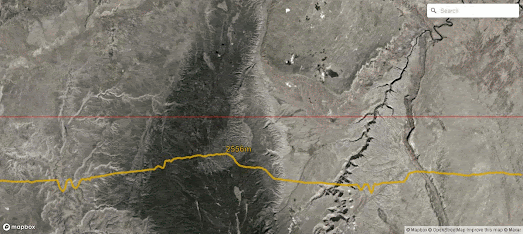The Altimeter

Steve Attewell was inspired by a recent QGIS experiment by Alasdair Rae to create an interactive terrain scanner.Steve's Terrain Elevation Viewer is an interactive map which visualizes elevation along a line of latitude.
The yellow line on the Terrain Elevation Viewer shows the elevation along the red line. The map uses Mapbox GL's queryTerrainElevation feature to return the elevation all the way along the red line on the map and visualizes this elevation value by the height of the yellow line. The result provides a cross section of the displayed terrain's elevation.
Alasdair Rae was inspired to create his elevation scanner in QGIS by Nicolas Lambert's Elevation Scan. Elevation Scan is another clever interactive map which visualizes the relative elevation of land across the world.
Press the 'play' button on Elevation Scan and a line moves north from the bottom of the map to the top. As the line moves a graph shows the elevation height along the line of latitude. For example on the screen shot above you can see the high elevations of the Himalayas rising up from the line of latitude running across the map.
If you press 'pause' you can manually explore the map and the relative elevation of locations around the world by moving the slide button left and right.

The Arun Valley in the South Downs National Park, England
You can also explore levels of elevation around the world using Peak Map. Peak Map is a fantastic interactive tool which you can use to create a joy-plot map for any location on Earth. To create your own joy-plot map you just need to center Peak Map on your chosen location and a very artistic elevation profile will be generated automatically by the map.
Joy-plots (or ridgeline plots as they are sometimes called) are inspired by Joy Division's famous album cover for their Unknown Pleasures record. Since the 1970's the Peter Saville designed cover for Unknown Pleasures has become an iconic image. The original cover was inspired by a visualization of the radio waves emitted by a pulsar, which was published in the Cambridge Encyclopaedia of Astronomy.
In data science a visualization which is inspired by this radio waves graph is often called a 'joy-plot' in acknowledgement of Joy Division's iconic album cover. Over the years a number of maps have used ridgeline plots or joy-plots to visualize different types of data, often to show population density or to visualize elevation. Using Peak Maps you can create your very own joy-plot visualizations of elevation data for any location on Earth.



Комментарии